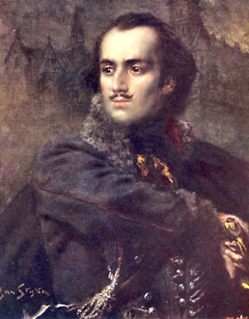
Kazimierz Michał Władysław Wiktor Pułaski of Ślepowron was a Polish nobleman, soldier and military commander who has been called, together with his Hungarian friend Michael Kovats de Fabriczy, "the father of the American cavalry".

Casimir Pulaski Day is a local holiday officially observed in Chicago, Illinois, on the first Monday of March in memory of Casimir Pulaski, a Revolutionary War cavalry officer born in Poland as Kazimierz Pułaski. He is praised for his contributions to the U.S. military in the American Revolution and known as "the father of the American cavalry".
General Pulaski Memorial Day is a United States holiday in honor of General Kazimierz Pułaski, a Polish hero of the American Revolution. This holiday is held every year on October 11 by Presidential Proclamation, to commemorate his death from wounds suffered at the Siege of Savannah on October 9, 1779 and to honor the heritage of Polish Americans. The observance was established in 1929 when Congress passed a resolution designating October 11 as General Pulaski Memorial Day. Every President has issued a proclamation for the observance annually since.

Michael Kovats de Fabriczy was a Hungarian nobleman and cavalry officer who served in the Continental Army during the American Revolutionary War, in which he was killed in action. General Casimir Pulaski and Kovats are together known as the "Founding Fathers of the US Cavalry."
Casimir Pulaski High School is a public high school located on 2500 W Oklahoma Ave in Milwaukee, Wisconsin. Casimir Pulaski is part of the Milwaukee Public School system. It is named after Casimir Pulaski, a Polish soldier of the American Revolutionary War. The school had 1600 students during the 2004-2005 school year.
Richard Henry Park was an American sculptor who worked in marble and bronze. He was commissioned to do work by the wealthy of the nineteenth century. He also created sculptures for the Chicago World's Fair of 1893.

Oliver Perry Monument is a bronze statue, by William Greene Turner, dedicated to Commodore Oliver Hazard Perry. It is located in Eisenhower Park in Newport, RI, between Washington Square and Touro street. The statue faces west towards Newport Harbor.
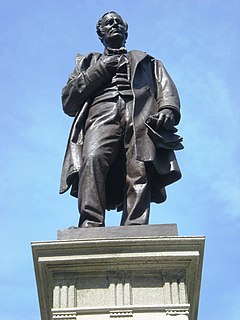
The Thomas A. Hendricks Monument is a public artwork by American artist Richard Henry Park and is located on the southeast corner of the Indiana Statehouse grounds in Indianapolis, Indiana. The monument is a tribute to Thomas A. Hendricks, the 21st Vice President of the United States. Hendricks was a former U.S. Representative and U.S. Senator from Indiana. He was the 16th Governor of Indiana and led the campaign to build the Indiana Statehouse.

The Victorious Charge is a public artwork by American artist John S. Conway located on the Court of Honor on West Wisconsin Avenue in downtown Milwaukee, Wisconsin, United States. The 1898 bronze sculpture is 9'10" high and sits on a 20' square granite pedestal.
Henry Bergh is a statue by American artist James H. Mahoney located at the Wisconsin Humane Society in Milwaukee, Wisconsin, United States. The bronze statue portrays Henry Bergh, the father of the humane movement in the United States, holding a cane in his proper right hand and petting a dog with a bandaged paw with his proper left hand. It was created in 1891 and stands 9 feet high.

Spirit of Commerce is a public artwork by German artist Gustav Haug located in Jackson Park, which is on the south side of Milwaukee, Wisconsin, United States. This zinc sculpture is 15 feet tall and sits on a red granite pedestal near the park's lagoon. It is the oldest public sculpture in Milwaukee.
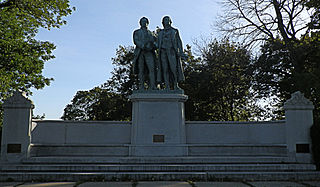
The Goethe–Schiller Monument is a public artwork by German artist Ernst Friedrich August Rietschel located in Washington Park, which is in Milwaukee, Wisconsin, United States. The bronze sculpture from 1908 depicts two men, Johann Wolfgang von Goethe and Friedrich von Schiller, one holding a laurel wreath and the other a scroll. The 12 foot artwork rests upon a 26 foot long granite base. The bronze sculpture is a recasting of the statue incorporated into the 1857 Goethe-Schiller Monument in Weimar, Germany.
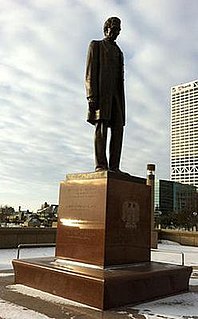
Abraham Lincoln is a public artwork by American artist Gaetano Cecere located on Lincoln Memorial Drive in Milwaukee, Wisconsin, United States. The 10'6" bronze sculpture depicts a young beardless Abraham Lincoln. The former president stands looking down with both hands at his sides.

The Washington Monument is a public artwork by American artist Richard Henry Park located on the Court of Honor in front of the Milwaukee Public Library Central Library, which is near Marquette University in Milwaukee, Wisconsin. The bronze sculpture is a full-length portrait of a 43-year-old George Washington, and stands on a granite pedestal; a bronze woman points up at Washington while a child, also made out of bronze, gazes upward. It was sculpted by Richard Henry Park and was erected in 1885 with philanthropic financial support from Elizabeth Plankinton. The statue was restored 2016-2018.

The R. D. Whitehead Monument is a public artwork by Norwegian born American artist Sigvald Asbjornsen located on the south side of Milwaukee, Wisconsin, United States. The artwork consists of a bronze-relief plaque depicting a dog and horse, set on a granite pillar, which is in turn part of a fountain.
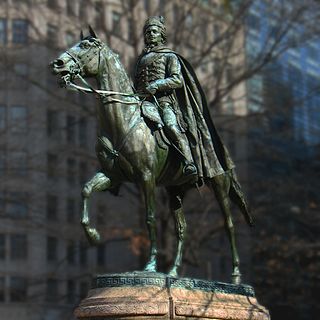
General Casimir Pulaski is a bronze equestrian statue, by Kazimierz Chodziński. It is located at Freedom Plaza, 13th Street and Pennsylvania Avenue, Northwest, Washington, D.C.

General Douglas MacArthur is a public artwork by American artist Robert L. Dean, a 1953 graduate of the United States Military Academy. Previously, the statue was located in MacArthur Square in the Milwaukee Civic Center Plaza, downtown Milwaukee, Wisconsin, USA. On June 7, 2014, it was relocated to its new waterfront location at Veterans' Park, next to the Milwaukee County War Memorial Center. With full military honors, the bronze statue of General Douglas MacArthur was rededicated at its new home on June 7, 2014. The ceremony was the capstone event for the MacArthur Memorial Week, held nearly 35 years after the statue's original dedication on June 8, 1979.

World War I Memorial Flagpole (Eagle) is a public artwork by American artist Benjamin Franklin Hawkins located on the lakefront in Milwaukee, Wisconsin, United States. The artwork was made in 1932 from bronze and granite. It measures approximately 80 inches in height, and it sits at the Northeast corner of North Prospect Avenue and Lincoln Memorial Drive.

Robert Burns is a public art statue of the Scottish national poet Robert Burns by the Scottish artist William Grant Stevenson.
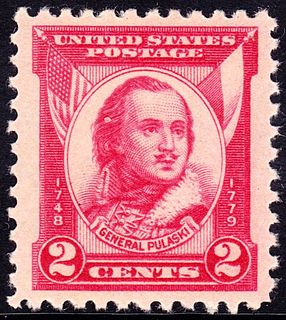
Casimir Pulaski was a Polish nobleman, soldier and military commander who has been called "the father of the American cavalry". He has had hundreds of monuments, memorial plaques, streets, parks and similar objects named after him.























